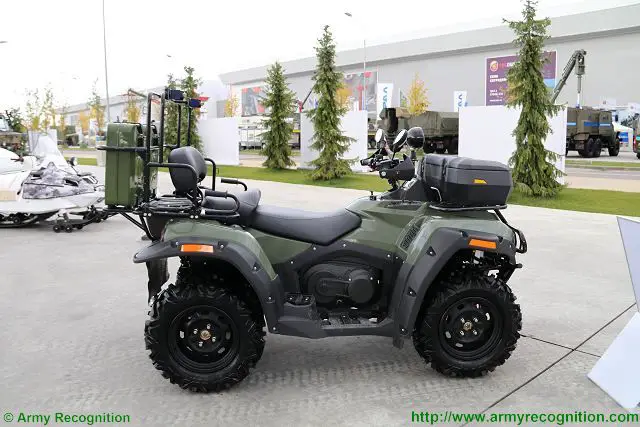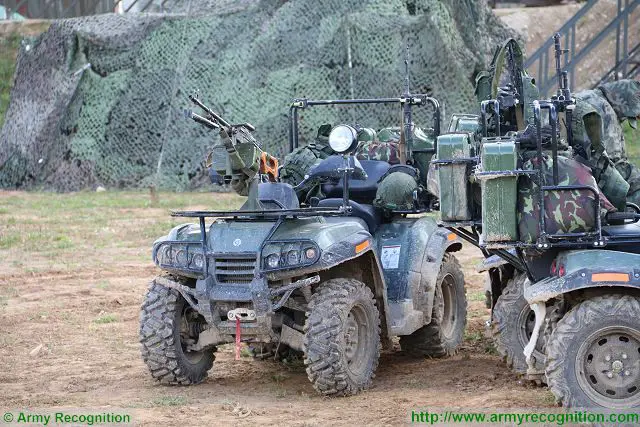Breaking news
Russian coastal defense division will receive quad bikes for use in the Arctic region TASS 11310164.
| 2016
|
|
|||
|
Defence & Security News - Russia
|
|||
|
|
|||
| Russian coastal defense division will receive quad bikes for use in the Arctic region | |||
|
The Russian coastal defense division, expected to be stationed in the Chukotka Peninsula in 2018, will be issued quad bikes, according to the Izvestia daily. The mission of the new Arctic infantry battalions is to patrol the coast and prevent the landing of enemy commandos. In case of a large-scale amphibious assault by hostile marines, the Arctic infantrymen will dash to their landing site and engage the enemy in stride.
|
|||
|
|
|||
 Russian AM1 Quad bikes all-terrain vehicle at Army 2016 International Military technical Forum near Moscow, Russia Russian AM1 Quad bikes all-terrain vehicle at Army 2016 International Military technical Forum near Moscow, Russia |
|||
|
|
|||
|
Several well-informed sources in the Russian Defense Ministry have explained that the decision to activate quadbike battalions had been made. However, the military is pondering how many new units are needed to guarantee the inviolability of the coastal border of Chukotka and what type of quad bike the Arctic infantry will ride.
The 80th Arctic Brigade has tested several types of quadbikes to date. The vehicles have gained raving reports, an Operational Command North officer close to the tests says. Certainly, on the face of it, it would be logical to issue the troops with snowmobiles. However, first, the troops are expected to operate near the waterline, where snow is not that thick, but stones are aplenty. Second, Chukotka does have brief summer when snow melts, making snowmobile useless. The mountain infantry and airborne units of the developed countries’ militaries have used quadbikes actively. "Certainly, the Special Forces have such vehicles," expert Alexei Khlopotov says. "In addition to the classic motorcycle-type single- and two-seat quad bikes, the manufacturers offer all-terrain vehicles looking like buggies and hauling four troops and 500-600 kg of cargo in a special compartment. It is the buggy-like quadbikes with cargo compartments that are being bought by foreign militaries by hundreds." According to the expert, the Russian quadbike market is large enough, and the Defense Ministry can pick and choose. |
|||
|
|
|||
 Russian army quad bike armed with 7.62mm machine gun at Army 2016 defense exhibition live demonstration near Moscow, Russia. Russian army quad bike armed with 7.62mm machine gun at Army 2016 defense exhibition live demonstration near Moscow, Russia. |
|||
|
|
|||
|
"Yamaha and BRP have always offered the most popular and reliable all-terrain vehicles on the Russian market, but they have encountered strong competition on the part of Russian firms, Russkaya Mekhanika in particular," Alexei Khlopotov says. "On the average, the cheapest two-seat quadbike costs 350,000 rubles ($5,500), while four-seat buggies go at more than 700,000 rubles ($11,000) a pop."
The tactical performance of advanced quadbikes is highlighted by the fact that the crews of four-seat all-terrain vehicles of the US Army’s 82 Airborne Division carry a .30-cal. machinegun and a Karl Gustav recoilless rifle in addition to their personal weapons. In the boot and cabin, there are several disposal rocket launchers and a Javelin ATGM system with a stock of missiles. The US paratroops use six-wheeled quadbikes to haul mortars with ammunition, MANPADS, automatic grenade launchers, etc. Now, Russian infantrymen fight on BMP-2 and BMP-3 infantry fighting vehicles (IFV) and BTR-80 and BTR-82 armored personnel carriers (APC). The Arctic infantrymen ride MTLB tractors and DT-30 Vityaz articulated vehicles featuring unique all-terrain capacity. "A standard infantry company is about 90-100 troops and 12-13 fighting vehicles. However, Arctic companies on quadbikes will have less personnel and vehicles. It is possible, therefore, that the newly activated coastal defense division will have heavily armed Arctic battalions on the MTLB too," expert Dmitry Boltenkov says. "The mission of the troops on quadbikes will be to kill enemy commandos and to patrol the coastline. If enemy marines hit the beach, the quadbike-mounted troops will need to maximize the enemy’s losses, fix it in position and prevent it from breaking through inland until friendly units with heavier weapons arrive." According to the expert, although a full-fledged amphibious landing operation in Chukotka does not look realistic, it is quite feasible, in fact. In the 1980s, there was the 99th Infantry Division stationed in Chukotka. Its mission was to defend against enemy marines. Truth be told, the division was reformed into a brigade some time later, then it shrank into a prepositioned equipment base and then was finally disbanded at all. At the same time, there are several military air detachments and an Orlan-10 unmanned aerial vehicle squadron in Chukotka now, according to the Izvestia daily. |
|||
|
|
|||
|
© Copyright 2016 TASS. All rights reserved. This material may not be published, broadcast, rewritten or redistributed.
|
|||



















